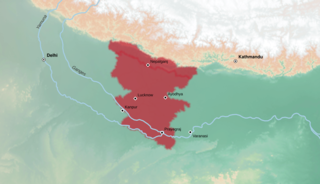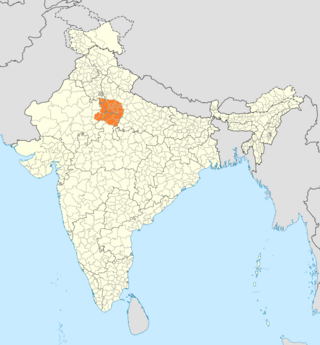
The Indo-Aryan languages are a branch of the Indo-Iranian languages in the Indo-European language family. As of the early 21st century, they have more than 800 million speakers, primarily concentrated in Bangladesh, India, Pakistan, Sri Lanka, Maldives and Nepal. Moreover, apart from the Indian subcontinent, large immigrant and expatriate Indo-Aryan–speaking communities live in Northwestern Europe, Western Asia, North America, the Caribbean, Southeast Africa, Polynesia and Australia, along with several million speakers of Romani languages primarily concentrated in Southeastern Europe. There are over 200 known Indo-Aryan languages.

Marwari is a language within the Rajasthani language family of the Indo-Aryan languages. Marwari and its closely related varieties like Dhundhari, Shekhawati and Mewari form a part of the broader Marwari language family. It is spoken in the Indian state of Rajasthan, as well as the neighbouring states of Gujarat and Haryana, some adjacent areas in eastern parts of Pakistan, and some migrant communities in Nepal. There are two dozen varieties of Marwari. Marwari is also referred to as simply Rajasthani.

Bhojpuri is an Indo-Aryan language native to the Bhojpur-Purvanchal region of India and the Terai region of Nepal. It is chiefly spoken in eastern Uttar Pradesh, western Bihar and western Jharkhand in India as well as western Madhesh and eastern Lumbini in Nepal. It is an eastern Indo Aryan language and as of 2000 it is spoken by about 5% of India's population. Bhojpuri is a descendant of Magadhi Prakrit and is related to Maithili, Magahi, Bangla, Odia, Assamese, and other eastern Indo-Aryan languages.

Bundeli or Bundelkhandi is an Indo-Aryan language spoken in the Bundelkhand region of central India. It belongs to the Central Indo-Aryan languages and is part of the Western Hindi subgroup.

Kauravi, also known as Khaṛībolī, is a dialect of Hindustani descended from Shauraseni Prakrit that is mainly spoken in northwestern Uttar Pradesh, outside of Delhi.

Magahi, also known as Magadhi, is a Indo-Aryan language spoken in Bihar, Jharkhand and West Bengal states of eastern India, and in the Terai of Nepal. Magadhi Prakrit was the ancestor of Magahi, from which the latter's name derives.

Awadhi, also known as Audhi, is an Indo-Aryan language spoken in the Awadh region of Uttar Pradesh in northern India and in Terai region of western Nepal. The name Awadh is connected to Ayodhya, the ancient city, which is regarded as the homeland of the Hindu god Rama. It was, along with Braj, used widely as a literary vehicle before being displaced by Hindi in the 19th century.
Hindustani is one of the predominant languages of South Asia, with federal status in the republics of India and Pakistan in its standardized forms of Hindi and Urdu respectively. It is widely spoken and understood as a second language in Nepal, Bangladesh, and the Persian Gulf and as such is considered a lingua franca in the northern Indian subcontinent. It is also one of the most widely spoken languages in the world by total number of speakers. It developed in north India, principally during the Mughal Empire, when the Persian language exerted a strong influence on the Western Hindi languages of central India; this contact between the Hindu and Muslim cultures resulted in the core Indo-Aryan vocabulary of the Indian dialect of Hindi spoken in Delhi, whose earliest form is known as Old Hindi, being enriched with Persian loanwords. Rekhta, or "mixed" speech, which came to be known as Hindustani, Hindi, Hindavi, and Urdu, also locally known as Lashkari or Lashkari Zaban in long form, was thus created. This form was elevated to the status of a literary language, and after the partition of colonial India and independence this collection of dialects became the basis for modern standard Hindi and Urdu. Although these official languages are distinct registers with regards to their formal aspects, such as modern technical vocabulary, they continue to be all but indistinguishable in their vernacular form. From the colonial era onwards, Hindustani has also taken in many words from English, with an urban English-influenced variety emerging known as Hinglish.

The Hindi Belt, also known as the Hindi Heartland, is a linguistic region encompassing parts of northern, central, eastern, and western India where various Northern, Central, Eastern and Western Indo-Aryan languages are spoken, which in a broader sense is termed as Hindi languages, with Standard Hindi serving as the lingua franca of the region.
Dramatic Prakrits were those standard forms of Prakrit dialects that were used in dramas and other literature in medieval India. They may have once been spoken languages or were based on spoken languages, but continued to be used as literary languages long after they ceased to be spoken. Dramatic Prakrits are important for the study of the development of Indo-Aryan languages, because their usage in plays and literature is always accompanied by a translation in Sanskrit.

Braj is a language within the Indo-Aryan language family spoken in the Braj region centered on Mathura. Along with Awadhi, it was one of the two predominant literary languages of North-Central India before being replaced by Hindi in the 19th century.
Magadhi Prakrit (Māgadhī) is of one of the three Dramatic Prakrits, the written languages of Ancient India following the decline of Pali and Sanskrit. It was a vernacular Middle Indo-Aryan language, replacing earlier Vedic Sanskrit.

Caribbean Hindustani is an Indo-Aryan language spoken by Indo-Caribbeans and the Indo-Caribbean diaspora. It is a koiné language mainly based on the Bhojpuri and Awadhi dialects. These Hindustani dialects were the most spoken dialects by the Indians who came as immigrants to the Caribbean from Colonial India as indentured laborers. It is closely related to Fiji Hindi and the Bhojpuri-Hindustani spoken in Mauritius and South Africa.

Fiji Hindi is an Indo-Aryan language spoken by Indo-Fijians. It is an Eastern Hindi and Bihari language, considered to be a koiné language based on Awadhi that has also been subject to considerable influence by Bhojpuri, other Eastern Hindi and Bihari dialects, and Standard Hindi-Urdu. It has also borrowed some vocabulary from English, Fijian, Telugu, Tamil, Bengali, Punjabi, Gujarati, and Malayalam. Many words unique to Fiji Hindi have been created to cater for the new environment that Indo-Fijians now live in. First-generation Indians in Fiji, who used the language as a lingua franca in Fiji, referred to it as Fiji Baat, "Fiji talk". It is closely related to Caribbean Hindustani and the Bhojpuri-Hindustani spoken in Mauritius and South Africa. It is largely mutually intelligible with the languages of Awadhi and Bhojpuri, as well as with the Bihari languages of Bihar, Uttar Pradesh, Jharkhand, Madhesh, Koshi and Lumbini, and the dialects of Eastern Hindi of Uttar Pradesh, Madhya Pradesh, Chhattisgarh and Lumbini, but differs in phonetics and vocabulary with Modern Standard Hindi and Urdu.

The Punjabi dialects and languages or Greater Panjabic are a series of dialects and languages spoken around the Punjab region of Pakistan and India with varying degrees of official recognition. They have sometimes been referred to as the Greater Punjabi macrolanguage. Punjabi may also be considered as a pluricentric language with more than one standard variety.

The Eastern Indo-Aryan languages, also known as Māgadhan languages, are spoken throughout the eastern region of the subcontinent, which includes Bihar, Uttar Pradesh, Jharkhand, Bengal region, Tripura, Assam, and Odisha; alongside other regions surrounding the northeastern Himalayan corridor. Bengali is official language of Bangladesh and the state of West Bengal, Tripura and the Barak valley of Assam while Assamese and Odia are the official languages of Assam and Odisha, respectively. The Eastern Indo-Aryan languages descend from Abahattha, which descends from Magadhan Apabhraṃśa and ultimately from Magadhi Prakrit.

The Central Indo-Aryan languages or Hindi languages are a group of Indo-Aryan languages spoken across Northern and Central India. These language varieties form the central part of the Indo-Aryan language family, itself a part of the Indo-European language family. They historically form a dialect continuum that descends from the Middle Prakrits. Located in the Hindi Belt, the Central Zone includes the Dehlavi (Delhi) dialect of the Hindustani language, the lingua franca of Northern India that is the basis of the Modern Standard Hindi and Modern Standard Urdu literary standards. In regards to the Indo-Aryan language family, the coherence of this language group depends on the classification being used; here only Eastern and Western Hindi languages will be considered.
Most of the languages of Bihar, the third most populous state of India, belong to the Bihari subgroup of the Indo-Aryan family. Chief among them are Bhojpuri, spoken in the west of the state, Maithili in the north, Magahi in center around capital Patna and in the south of the state. Maithili has official recognition under the Eighth Schedule to the Constitution of India. The official language of Bihar is Modern Standard Hindi, with Standard Urdu serving as a second official language in 15 districts.

The Eastern Hindi languages, also called East Central languages, are a branch of the Indo-Aryan language family spoken chiefly in Awadh region of Uttar Pradesh, Baghelkhand region of Madhya Pradesh, and Chhattisgarh, in Northern and Central India. Eastern Hindi languages evolved from Ardhamagadhi Prakrit.
Ardhamagadhi Prakrit was a Middle Indo-Aryan language and a Dramatic Prakrit thought to have been spoken in modern-day Bihar and Uttar Pradesh and used in some early Buddhist and Jain dramas. It was likely a Central Indo-Aryan language, related to Pali and the later Shauraseni Prakrit. The Eastern Hindi languages evolved from Ardhamagadhi Prakrit.













